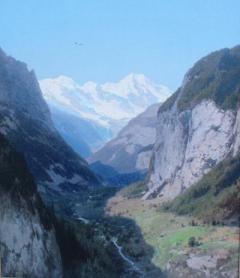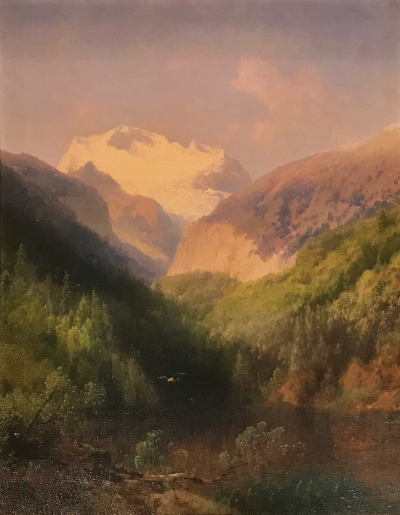Hermann Herzog
American, 1832 - 1932
Hermann Herzog (1832–1932)
Born in Bremen, Germany, Hermann Herzog emerged as a prominent landscape painter whose artistic journey spanned continents and a century. He began his studies at the Düsseldorf Academy in 1848, where he was mentored by notable artists like Schirmer, Lessing, Achenbach, and Gude. Their encouragement to explore “scenic beauty and inspiration” shaped Herzog’s dedication to landscape painting, which became his primary focus.
Herzog achieved early acclaim, exhibiting his works in Germany and France and winning a prize at the prestigious Paris Salon in 1863. His clientele included royals such as Queen Victoria and Grand Duke Alexander of Russia, underscoring his reputation in elite circles. Between 1863 and 1869, he established an American market for his art by submitting works to the Pennsylvania Academy’s annual exhibitions.
In 1869, amid the political turmoil of the Austro-Prussian War, Herzog immigrated to the United States with his family, settling in Philadelphia. He traveled extensively throughout the eastern U.S., capturing the beauty of iconic locations such as Niagara Falls, Lake George, and the Chesapeake Bay in his meticulous style. Herzog was known for his early morning excursions to capture the delicate interplay of light and atmosphere at dawn.
His explorations took him westward in the mid-1870s, where he discovered the dramatic landscapes of Utah, Oregon, and Yosemite Valley. Towards the end of the 19th century, he began creating Florida landscapes, reflecting the region's lush tropical foliage.
Herzog’s ability to evoke emotion through nature is evident in works like "A Walk along a Path at Sunset," where a lone figure blends harmoniously into the serene landscape. His versatility as an artist is reflected in the variety of landscapes he painted—from the rugged fjords of Norway to the tranquil woodlands of the East Coast.
In addition to his exhibitions at the Pennsylvania Academy, Herzog showcased his work at the National Academy of Design and the Brooklyn Art Association. He received accolades such as a bronze medal at the Centennial Exhibition in Philadelphia in 1876. Today, his paintings are housed in prestigious collections, including the Metropolitan Museum of Art, the Smithsonian American Art Museum, and the Museum of Fine Arts in Boston.
Herzog's long life and prolific career resulted in over 1,000 canvases, leaving a lasting legacy in American landscape painting. His work, characterized by realism and tonalism, reflects a romantic view of the world and showcases his unique artistic vision, solidifying his place among the notable landscape painters of his time.
Hermann Herzog
Large antique Orientalist painting of Tangier, Morrocco by Herzog
H 26.38 in W 34.25 in D 2.36 in
$ 95,000
